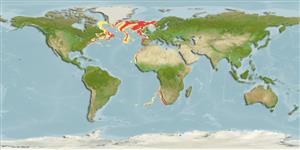Teleostei (teleosts) >
Perciformes/Zoarcoidei (Eelpouts and pricklebacks) >
Zoarcidae (Eelpouts) > Lycodinae
Etymology: Lycodes: Greek, lykos = wolf + Greek, suffix, oides = similar to (Ref. 45335).
Environment: milieu / climate zone / depth range / distribution range
Ecology
Marine; bathydemersal; depth range 150 - 2604 m (Ref. 58018). Deep-water; 65°N - 36°S, 77°W - 19°E (Ref. 117245)
Western Atlantic: Davis Strait, off Newfoundland and Middle Atlantic Bight. Eastern Atlantic: Rockall Trough/ Bill Bailey Bank, off Mauritania and off southwestern Africa.
Size / Weight / Age
Maturity: Lm ? range ? - ? cm
Max length : 45.2 cm TL male/unsexed; (Ref. 6950)
Short description
Identification keys | Morphology | Morphometrics
Dorsal soft rays (total): 15 - 17. Body uniformly brown with dark fins. Head pores unreduced. Lateral line system with dorsolateral, a mediolateral and a ventral lateral line. Long tail, preanal 33.5-45.9% SL. Body scaled, including neck, fins and abdomen (Ref. 27255). Differs from sympatric species L. vahlii and L. esmarkii by its uniform coloration (vs. bars or marks present), lack of predorsal lateral line, smaller and fewer palatine teeth (3-5 vs. 8-22 and 5-13 respectively) and position of the last precaudal vertebrae in relation to dorsal fin (ray number 15-17 vs.18-19 and 19-20 respectively) (Ref. 36375).
Benthic; feeds on sponge remains, worms, molluscs, pycnogonids, crustaceans and brittle stars (Ref. 58426). Species forgotten in CLOFNAM (10007) and FNAM (4695).
Life cycle and mating behavior
Maturity | Reproduction | Spawning | Eggs | Fecundity | Larvae
Anderson, M.E., 1994. Systematics and osteology of the Zoarcidae (Teleostei: Perciformes). Ichthyol. Bull. J.L.B. Smith Inst. Ichthyol. 60:120 p. (Ref. 11954)
IUCN Red List Status (Ref. 130435: Version 2024-2)
Threat to humans
Harmless
Human uses
Tools
Special reports
Download XML
Internet sources
Estimates based on models
Preferred temperature (Ref.
123201): 3.1 - 7.1, mean 4.1 °C (based on 329 cells).
Phylogenetic diversity index (Ref.
82804): PD
50 = 0.5000 [Uniqueness, from 0.5 = low to 2.0 = high].
Bayesian length-weight: a=0.00182 (0.00103 - 0.00323), b=3.20 (3.04 - 3.36), in cm total length, based on LWR estimates for this species & (Sub)family-body (Ref.
93245).
Trophic level (Ref.
69278): 3.5 ±0.45 se; based on food items.
Resilience (Ref.
120179): Very Low, minimum population doubling time more than 14 years (Preliminary K or Fecundity.).
Fishing Vulnerability (Ref.
59153): Moderate vulnerability (35 of 100).
